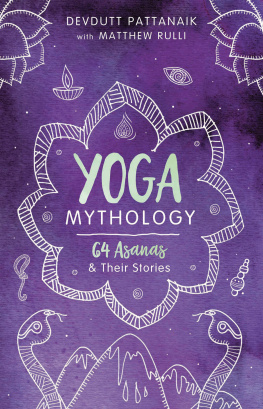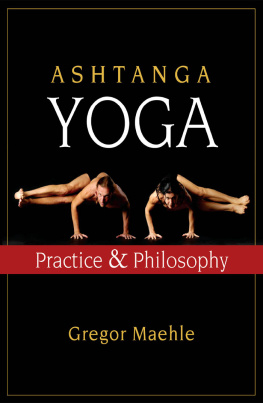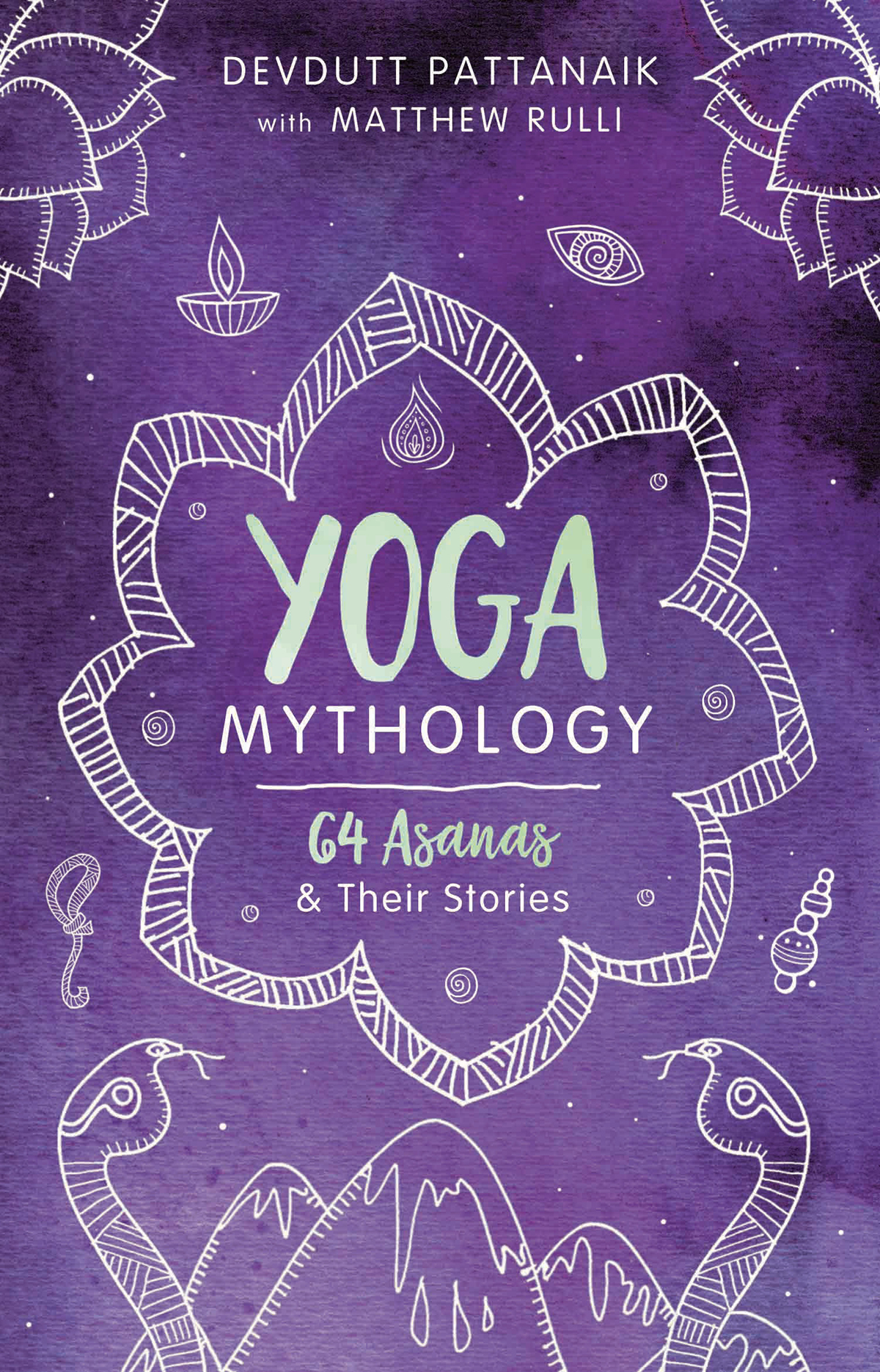Devdutt Pattanaik , renowned mythologist from India, author of over fifty books and over 1,000 columns on the subject, and a TED speaker, has written and illustrated this book. He has structured it in a way that makes the subject accessible to an international audience.
Matthew Rulli , former Marine and an experienced registered yoga teacher (E-RYT 500) from the US, who has been studying Sanskrit and Eastern philosophy for over a decade, felt the need for such a book among yoga enthusiasts and initiated this project by contacting Devdutt Pattanaik in 2017. Over the next two years, he listed asanas and served as the model, photographer, and commentator for the sixty-four postures finally selected for this book.

v Llewellyn Publications
Woodbury, Minnesota
Copyright Information
vi Yoga Mythology: 64 Asanas and Their Stories 2022 by Devdutt Pattanaik with Matthew Rulli.
All rights reserved. No part of this book may be used or reproduced in any matter whatsoever, including Internet usage, without written permission from Llewellyn Publications, except in the form of brief quotations embodied in critical articles and reviews.
As the purchaser of this e-book, you are granted the non-exclusive, non-transferable right to access and read the text of this e-book on screen. The text may not be otherwise reproduced, transmitted, downloaded, or recorded on any other storage device in any form or by any means.
Any unauthorized usage of the text without express written permission of the publisher is a violation of the authors copyright and is illegal and punishable by law.
First e-book edition 2022
E-book ISBN: 9780738771687
First published in hardback in India by HarperCollins Publishers in 2019
A-75, Sector 57, Noida, Uttar Pradesh 201301, India
www.harpercollins.co.in
Cover design by Kevin R. Brown
Interior illustrations by Devdutt Pattanaik
Interior photos by Matthew Rulli
Typeset by Special Effects Graphics Design Co., Mumbai
Llewellyn Publications is an imprint of Llewellyn Worldwide Ltd.
Library of Congress Cataloging-in-Publication Data (Pending)
ISBN: 978-0-7387-7064-2
Llewellyn Publications does not participate in, endorse, or have any authority or responsibility concerning private business arrangements between our authors and the public.
Any Internet references contained in this work are current at publication time, but the publisher cannot guarantee that a specific reference will continue or be maintained. Please refer to the publishers website for links to current author websites.
Llewellyn Publications
Llewellyn Worldwide Ltd.
2143 Wooddale Drive
Woodbury, MN 55125
www.llewellyn.com
Manufactured in the United States of America
ix
To the many generations of students and teachers of yoga,
especially those who have helped me experience yoga in this life:
from the simplicity of the Yoga Institute (Yogendra school)
to the precision of the Iyengar school.
Devdutt Pattanaik
xi
Contents
by Matthew Rulli
: Yogas Narrative Canvas
xii
xiii
: Metaphors of the Yogini
Acknowledgments
By Matthew Rulli
I would like to dedicate my contribution to this book to my teachers: Dave, whose love of stories like these ignited my own fascination for yoga mythology, and Cheryl, whose friendship, guidance, and wisdom have been some of the greatest influences on my life.
And to my son, Bradley, for teaching me that I could truly love and care for someone more than myself, and for being the sweetest, most compassionate person that I have ever knownI adore you.
My sincerest gratitude to Devdutt. When I first considered the idea of writing a book on yoga mythology, I knew that, even after years of research, I would never be able to produce a work worthy of the subject matter, especially after reading books like Devdutts Jaya , Indian Mythology , and the Seven Secrets series. When I sent him an email, I didnt even expect xvi a response, and I certainly didnt expect an invitation to work together on the project. It has been a tremendous privilege and honor, not only to be involved in the making of the book, but also to share a creative space with such an inspiring and brilliant mind.
I would also like to thank my mother and the rest of my family for their boundless love and support. Leo, for the friendship and for introducing me to yoga in the first place. My teachers, Carlyn, Marivic, Julie, and John, for their dedication to sharing their knowledge and preserving the yoga tradition. The gurus, Patanjali, Shri T. Krishnamacharya, Srivatsa Ramaswami, Pattabhi, and Sharath Jois, B. K. S. Iyengar, and all those who helped to carry the gift of yoga through the ages.
And finally, my thanks to you, the reader, for without your interest and support, this book would not be possible. I hope it inspires in you as much fascination and appreciation for the indescribable depth and richness that this mythology gives to the practice of yoga as it has for me.
Matthew Rulli
Authors Note
xvii This is not a book on the practice of yoga.
This is about the mythology that nurtured the idea of yoga.
W e live in times when the Buddha has become a spa icon, and the pursuit of health has been reduced to losing weight and developing a six-pack to indulge vanity. People see health as a secular activity, divorced from religion or spirituality, which are either disdainfully dismissed or expressed with unnecessary aggression. Few acknowledge the psychological and social role played by faith, or the relationship between the physical, the psychological, and the social. It has become difficult to speak of yoga without plunging into acrimonious debates on whether it is simply a fitness regime or if there is anything xviii spiritual (mystical or occult), religious (Hindu or Buddhist or Jain), or cultural (Indian) about it.
Radical Hindus, including those who do not live in India anymore, tend to be territorial about yoga and insist on looking at it as puritanical (a colonial hangover) and devotional, ignoring the role of sensuous yoginis and the importance of magical powers associated with yogis in folklore. They fear yoga is being culturally appropriated by the West, in response to which many Western academicians have sought to strip yoga of its roots, arguing that modern yoga owes more to European colonizers and American entrepreneurship and less to Indian sages or Hindu customs and beliefs.
To avoid controversy, therefore, and to ensure that the benefit of yoga reaches a wide audience, many yoga teachers dissociate yoga from its heritage and make it more about health than about wisdommore about the body and less about the mind, and even less about the spirit. As a result, few who practice yoga around the world are aware of the underlying yoga philosophy, and even fewer are aware of yoga mythology: stories, symbols, and rituals that shaped the worldview in which yoga was nurtured for over 3,000 years. This book hopes to fill this knowledge gap in a manner and tone that is playful rather than pedantic; it presents a truth, not the truth.
Many find the use of the word Indian problematic, insisting instead on geographical phrases like South Asia or specific religious qualifications like Hindu or Buddhist or Jain. This is the malaise of academicians in the humanities who seek to compete with the precision of the pure sciences. This book uses the word xix Indic loosely to refer to ideas that primarily originated and were nurtured in the Indian subcontinent (South Asia) and which, even today, dominate both cultural and religious expression in the region.








